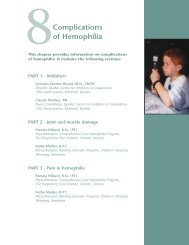BLOOD matters - Société Canadienne de l'Hémophilie
BLOOD matters - Société Canadienne de l'Hémophilie
BLOOD matters - Société Canadienne de l'Hémophilie
Create successful ePaper yourself
Turn your PDF publications into a flip-book with our unique Google optimized e-Paper software.
HCV News<br />
CWOR<br />
About the Disease<br />
Hemophilia B is characterized by severe<br />
episo<strong>de</strong>s of external and internal<br />
bleeding, resulting in significant morbidity.<br />
The episo<strong>de</strong>s cause long-term<br />
damage, for instance to the joints,<br />
and may be fatal if they occur in the<br />
brain. The <strong>de</strong>fect in blood clotting<br />
in hemophilia B is caused by the absence<br />
of functional clotting Factor IX<br />
as a result of mutations in the gene<br />
encoding this protein. The factor IX<br />
gene is located on the X chromosome.<br />
It is an X-linked recessive trait,<br />
which explains why only males are<br />
usually affected.<br />
Hemophilia B is a rare disease, occurring<br />
in 1 in 30,000 people, almost<br />
always in males. The total number<br />
of patients in Europe and the USA<br />
together is estimated to be between<br />
35,000 and 40,000.<br />
Currently, frequent intravenous<br />
administrations of recombinant Factor<br />
IX are required to stop or prevent<br />
bleeding. Protein replacement therapy<br />
is costly, cumbersome and does<br />
not completely prevent bleeding.<br />
Amsterdam Molecular Therapeutics<br />
AMT, foun<strong>de</strong>d in 1998 and based in<br />
Amsterdam, is a lea<strong>de</strong>r in the <strong>de</strong>velopment<br />
of human gene based therapies.<br />
Using AAV as the <strong>de</strong>livery vehicle<br />
of choice for therapeutic genes, the<br />
company has been able to <strong>de</strong>sign and<br />
validate what is probably the first<br />
stable and scalable AAV production<br />
platform. This safe and efficacious<br />
proprietary platform offers a unique<br />
manufacturing capability which can<br />
be applied to a large number of rare<br />
(orphan) diseases that are caused<br />
by one faulty gene. Currently, AMT<br />
has a product pipeline with several<br />
AAV-based gene therapy products in<br />
LPLD, Hemophilia B, DMD, Acute Intermittent<br />
Porphyria and Parkinson’s<br />
Disease at different stages of research<br />
or <strong>de</strong>velopment. <br />
20\ Blood Matters Fall 2010<br />
Hepatitis C damages brain cells<br />
by Catherine Scott<br />
October 20, 2010<br />
University of Alberta virologists have recently confirmed that the<br />
hepatitis C virus (HCV), commonly known as a disease that affects the liver,<br />
also adversely affects certain cells in the brain.<br />
Working with a team of virologists, Dr. Christopher Power and Dr. Pornpun<br />
Vivithanaporn exposed a hepatitis C protein to glial cells—the structural cells<br />
of the brain—and discovered that it is possible to infect them. The infected<br />
cells also release toxic factors that can potentially damage neurons.<br />
The findings are important because of the number of HIV patients that<br />
contract hepatitis C as well.<br />
Because HIV is known to cause<br />
neurological damage, the U of<br />
A study consi<strong>de</strong>red both of the<br />
infections in or<strong>de</strong>r to <strong>de</strong>termine<br />
that hepatitis C can cause neurological<br />
complications on its own.<br />
Once a glial cell is infected<br />
with a hepatitis C protein, it<br />
becomes inflamed and releases<br />
viral proteins, which interrupts<br />
autophagy—or the “self-eating”<br />
mechanism—which is the process<br />
in healthy neurons that<br />
<strong>de</strong>vours unwanted proteins.<br />
From this, neurons accumulate<br />
un<strong>de</strong>sirable proteins, stop working<br />
properly, and could die. Power noted that the results of this study could<br />
educate people on an infection whose effects they do not fully grasp.<br />
“This raises awareness of the adverse impact of hepatitis C on the brain<br />
because people really don’t have an appreciation of that,” he said.<br />
Power ad<strong>de</strong>d that, as a neurologist, many of his hepatitis C patients complain<br />
of memory and concentration impairment. However, until now, the<br />
virus’ presence in the brains of infected patients had not been confirmed.<br />
“We were the first people to show that, in fact, you can infect brain cells.<br />
That in itself, is a technical advance,” he said.<br />
Power explained that these findings may provi<strong>de</strong> greater insight in <strong>de</strong>veloping<br />
and improving a<strong>de</strong>quate treatment options for hepatitis C.<br />
“Treatment is limited to a combination of a drug called interferon-alpha<br />
and another drug called ribavirin. Interferon has really nasty si<strong>de</strong> effects.<br />
It makes people confused and <strong>de</strong>pressed, and it only works in a subset of<br />
patients, <strong>de</strong>pending on the type of virus you have. So any new treatments<br />
would be beneficial to hepatitis C,” Power said.<br />
Vivithanaporn echoed this statement, noting that the strain of hepatitis C<br />
found in North America is a particularly stubborn one. He also stressed the<br />
importance of this technical advance, which is but one step toward further<br />
discoveries about hepatitis C’s impact on the brain.<br />
“It’s kind of exciting to us because most people perceive this virus as the<br />
one that injures the liver, but this is the first time we’ve shown that it actually<br />
can infect glial cells [in the brain] too. We found that maybe it is part of the<br />
link to the neurological complications. That’s what is exciting about that.”
















